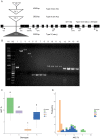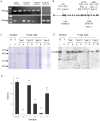Waxy allele diversification in foxtail millet (Setaria italica) landraces of Taiwan
- PMID: 30596758
- PMCID: PMC6312202
- DOI: 10.1371/journal.pone.0210025
Waxy allele diversification in foxtail millet (Setaria italica) landraces of Taiwan
Abstract
Foxtail millet (Setaria italica (L.) P. Beauv.), the second most cultivated millet species, is well adapted to diverse environments and remains an important cereal food and forage crop in arid and semiarid regions worldwide. A symbolic crop for indigenous Austronesian peoples, foxtail millet has been cultivated in Taiwan for more than 5,000 years, and landraces reflect diversifying selection for various food applications. A total of 124 accessions collected within Taiwan were assessed for Wx genotypes. Four identified Wx alleles, I, III, IV, and IX were caused by insertion of various transposable elements (TEs) and resulted in endosperm with non-waxy, low amylose content (AC), and waxy, respectively. A total of 16.9%, 4.0%, 49.2%, and 29.8% of accessions were classified as type I, III, IV, and IX, respectively; approximately half of the accessions belonged to the waxy type, indicating that glutinous grains were favored for making traditional food and wine. The TE insertion affected splicing efficiency rather than accuracy, leading to significantly reduced expression of wx in types III, IV, and IX, although their transcripts were the same as wild-type, type I. Consequently, the granule-bound starch synthase I (GBSSI) contents of the three mutated genotypes were relatively low, leading to waxy or low AC endosperm, and the Wx genotypes could explain 78% of variance in AC. The geographic distribution of Wx genotypes are associated with culinary preferences and migration routes of Taiwanese indigenous peoples-in particular, the genotype of landraces collected from Orchid Island was distinct from those from Taiwan Island. This information on the major gene regulating starch biosynthesis in foxtail millet endosperm can be applied to breeding programs for grain quality, and contributes to knowledge of Austronesian cultures.
Conflict of interest statement
The authors have declared that no competing interests exist.
Figures




Similar articles
-
Allelic variation of the Waxy gene in foxtail millet [Setaria italica (L.) P. Beauv.] by single nucleotide polymorphisms.Mol Genet Genomics. 2008 Mar;279(3):255-66. doi: 10.1007/s00438-007-0310-5. Epub 2007 Dec 19. Mol Genet Genomics. 2008. PMID: 18157676
-
Structural variation in the Waxy gene and differentiation in foxtail millet [Setaria italica (L.) P. Beauv.]: implications for multiple origins of the waxy phenotype.Mol Genet Genomics. 2002 Oct;268(2):214-22. doi: 10.1007/s00438-002-0728-8. Epub 2002 Aug 24. Mol Genet Genomics. 2002. PMID: 12395195
-
Genetic structure of landraces in foxtail millet (Setaria italica (L.) P. Beauv.) revealed with transposon display and interpretation to crop evolution of foxtail millet.Genome. 2011 Jun;54(6):498-506. doi: 10.1139/g11-015. Epub 2011 May 30. Genome. 2011. PMID: 21623678
-
Molecular insights on the origin and development of waxy genotypes in major crop plants.Brief Funct Genomics. 2024 May 15;23(3):193-213. doi: 10.1093/bfgp/elad035. Brief Funct Genomics. 2024. PMID: 38751352 Review.
-
Foxtail millet: a model crop for genetic and genomic studies in bioenergy grasses.Crit Rev Biotechnol. 2013 Sep;33(3):328-43. doi: 10.3109/07388551.2012.716809. Epub 2012 Sep 18. Crit Rev Biotechnol. 2013. PMID: 22985089 Review.
Cited by
-
Physics-Informed Machine Learning Improves Detection of Head Impacts.Ann Biomed Eng. 2022 Nov;50(11):1534-1545. doi: 10.1007/s10439-022-02911-6. Epub 2022 Mar 18. Ann Biomed Eng. 2022. PMID: 35303171
-
How ambient temperature affects the heading date of foxtail millet (Setaria italica).Front Plant Sci. 2023 Mar 2;14:1147756. doi: 10.3389/fpls.2023.1147756. eCollection 2023. Front Plant Sci. 2023. PMID: 36938030 Free PMC article.
-
Variation of growth and transcriptome responses to arbuscular mycorrhizal symbiosis in different foxtail millet lines.Bot Stud. 2023 Jun 16;64(1):16. doi: 10.1186/s40529-023-00391-y. Bot Stud. 2023. PMID: 37326894 Free PMC article.
-
Genetic Variation of Physicochemical Properties and Digestibility of Foxtail Millet (Setaria italica) Landraces of Taiwan.Molecules. 2019 Nov 26;24(23):4323. doi: 10.3390/molecules24234323. Molecules. 2019. PMID: 31779254 Free PMC article.
References
-
- Saleh ASM, Zhang Q, Chen J, Shen Q. Millet Grains: Nutritional Quality, Processing, and Potential Health Benefits. Comprehensive Reviews in Food Science and Food Safety. 2013;12(3):281–95.
-
- Austin DF. Foxtail millets (Setaria: Poaceae)-Abandoned food in two hemispheres. Econ Bot. 2006;60(2):143–58.
-
- Baltensperger DD. Progress with proso, pearl and other millets In: Janick J, Whipkey A, editors. Trends in new crops and new uses. Alexandria, VA: ASHS Press; 2002.
Publication types
MeSH terms
Substances
LinkOut - more resources
Full Text Sources

